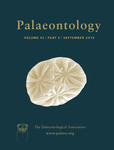Reg. Charity No. 1168330

We reconstruct the apparatus architecture of the gondollelid conodont Nicoraella kockeli based on fused clusters from the early Middle Triassic (middle Anisian, Pelsonian) of Luoping County, east Yunnan Province, south‐west China. This material was characterized non‐invasively using synchrotron x‐ray tomographic microscopy and the ensuing data analysed using computed tomography, allowing us to infer the composition, homologies and architectural arrangement of elements within the apparatus. Much of the original three‐dimensional architecture of the apparatus is preserved and our apparatus reconstruction is the best characterized of any taxon within the superfamily Gondolelloidea. This allows us to test architectural models for gondolelloids and prioniodinins, more generally, as well as the functional interpretations based upon them. In particular, we reject a recent functional interpretation of the conodont feeding apparatus which was based on a biomechanically‐optimized inference of apparatus architecture in a close gondolelloid relative of Nicoraella. Nevertheless, our architectural model provides a foundation for future functional interpretations of gondolleloids and prioniodinins, more generally.